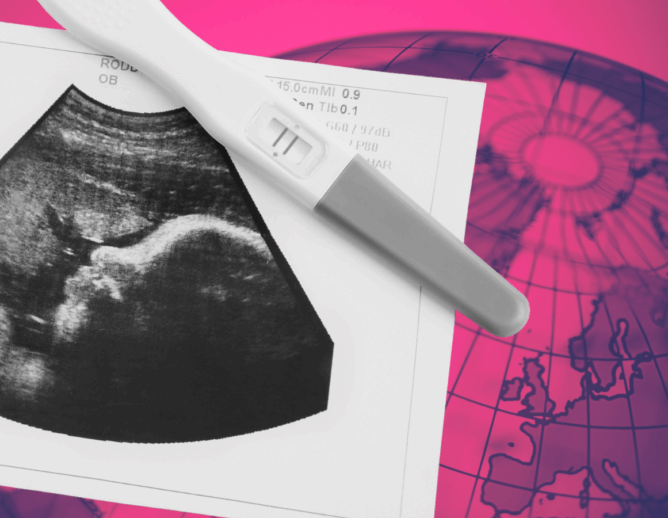What Is a Birth Center?
Despite continued advancements in medical care, childbirth is deadlier in the United States than in any other high-income nation, especially for Black and brown people. As racial disparities widen, access to basic care is further constricted by underfunded maternity wards shuttering across the country. In response to these ongoing challenges, pregnant people are increasingly seeking birth experiences at freestanding birth centers.
Operating separately from a hospital, birth centers use a midwifery model of care to provide services during pregnancy, delivery, and postpartum for people with low-risk pregnancies. In contrast to the standard obstetrics model, birth centers emphasize the autonomy of pregnant people and their families to make informed decisions about their birth experiences. Often, they have a mission rooted in reproductive justice, particularly centering the experiences of Black women who frequently experience violence at the hands of medical professionals. By respecting the pregnant person’s autonomy and supporting their informed choices about the health care they desire, birth centers can provide a more positive birth experience and relaxing environment. Birth centers also differ from hospital environments in that they provide a home-like atmosphere, creating a safe and comfortable place to give birth. This can include accommodations, such as birthing tubs, outdoor space, yoga, and meditation rooms.
Various positive health outcomes are associated with birth center and midwifery
care. Studies show that people who utilize birth centers report higher rates of satisfaction with care, compared to those who give birth in a hospital setting. Overall, birth center care is associated with increased rates of vaginal birth, increased breastfeeding rates, reduced preterm births, and fewer medical interventions — resulting in cost savings. On average, childbearing people save $2,000 when they receive care in a birth center instead of a hospital. One study found that shifting 10% of births to birth centers would result in cost savings of nearly $2 billion yearly. In summary, birth center care has consistently been shown to increase the quality of care, while decreasing costs for the pregnant person and the hospital system.
Barriers to Access
Although freestanding birth centers represent a promising breakthrough in reducing maternal mortality, regulatory barriers impede widespread access to them. In California, birth centers are closing due to onerous state regulations; at least 19 birth centers in California have shut down or reduced services in the last four years. Today, four main policies restrict access to birth centers: 1) certificate of need requirements, 2) transfer agreements, 3) requirements for the center to have a medical director or physician on staff, and 4) requirements regarding building design. While these requirements are applied with positive intentions, in practice, they obstruct access to birth centers, without evidence that their implementation supports better birth outcomes.
Certificate of Need
A certificate of need (CON) law requires state or local approval to create or expand health care facilities within a particular geographic area. CON requirements were originally intended to reduce costs by avoiding duplicative services and improving the quality of facilities. However, data shows that CON requirements actually drive up health care costs in the area by stifling competition and allowing existing healthcare facilities to maintain a monopoly. Furthermore, they impose unnecessary burdens on establishing freestanding birth centers. CON requirements were designed to regulate hospitals; birth centers should not be subject to the same stringent requirements because the environment and needs of birth centers are distinct from those of a hospital. There is no evidence that CON laws improve the safety or quality of centers, and national birth center standards developed by experts achieve the same goals. Complying with CON requirements imposes significant financial burdens on birth centers, especially smaller independent ones that operate without major financial backing. Although well-intended, CON laws impose unnecessary burdens on birth centers and do not achieve their intended goals of improving health care delivery.
Transfer Agreements
Transfer agreements are agreements between a birth center and a hospital that state a birthing person or their newborn can be transferred from the center to the hospital in case of an emergency or medical complication. Instances where a transfer is needed are rare, given that birth centers focus on low-risk pregnancies; however, transfer agreements are often required for a birth center to operate.
Two main issues arise with transfer agreements. First, if a transfer occurs, a birth center may not receive a Medicaid or other insurance payment for care provided up to the transfer, or may receive a reduced payment. This occurs because reimbursements are paid to the facility where the actual birth happened and often do not include the facility where resources were utilized during labor. Second, risk-averse hospitals may be hesitant to enter into agreements. Thus, in areas with limited hospital access, especially rural areas, birth centers are difficult to open.
Transfer agreements are a unique restriction placed on reproductive health care providers, such as abortion clinics. Notably, transfer agreements are not required for other health care facilities. Instead of placing barriers in the way for people to access birth center care, hospitals should be expected to cooperate in planning the rare transfers of birthing people experiencing emergencies.
Medical Director/Physician Requirement
Some states require that birth centers have a medical director or supervising physician on staff at the birth center. This requirement can be interpreted as paternalistic and invalidating to the expertise and training of midwives and other birth workers at the center. National birth center standards state that a center should have a clinical director, who can be a physician or a midwife. Data indicates that the presence of a medical director or physician to oversee a birth center is not associated with better health outcomes. Physicians are rarely trained in the operative midwifery model of care in birth centers and are, therefore, not familiar with the accepted practices. Similar to transfer agreements, this requirement is especially problematic in communities where physicians have liability concerns and will not enter into an agreement with the birth center. Setting a positive standard for other states to follow, Massachusetts recently passed a law to issue birth center guidance aligned with national standards set by the American Association of Birth Centers.
Building Requirements
Like any other health care facility, birth centers must meet construction, fire, health, and safety codes. However, issues arise when state law requires birth centers to follow the same standards as hospitals or other health facilities, which are not shown to improve safety. Birth centers do not have the same layout or equipment as hospitals, because they do not provide all of the same services. For example, requiring operating room lighting and sinks with elbow controls is unnecessary for low-intervention births and only increases costs for centers.
As demand for birth centers increases, some states are taking steps to address these concerns. A law recently passed in Massachusetts directs the state health department to review a state requirement that birth centers follow the same building standards as outpatient surgical centers. Even though states continue to impose restrictive building requirements for birth centers, studies demonstrate that no particular birth room size or configuration is safer than another. Similar to the other barriers discussed above, certain building requirements imposed on birth centers are not rooted in evidence of improved care and only restrict access.
Looking Forward
Birth centers are a critical resource as the United States works to address the public health crisis of maternal mortality. The structural barriers restricting access to these centers must be addressed to improve maternal health outcomes and increase reproductive justice. As obstetric violence only increases post-Dobbs, it is especially important that states seek community-centered solutions, in order to reduce racial disparities in birth outcomes. As noted above, state legislatures are taking action to remove these barriers and increase access to birth centers. The American Association of Birth Centers has model regulations that can be introduced, passed, and implemented at the state level to facilitate the opening of more birth centers.
Advocates, midwives, clinicians, and other stakeholders must continue to inform policymakers about the benefits of birth centers to support reproductive justice and improve maternal health outcomes.
DISCLAIMER: The views and opinions expressed in this piece are those of the author and do not reflect the views of the O’Neill Institute.



